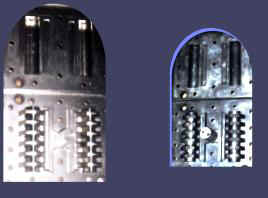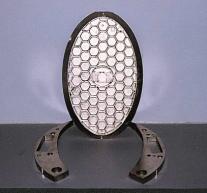

Electroless Nickel Plating.
 |


At Hycrome Thane , size is not a constraint. We have
more than 15 tanks of various dimensions.
We have High Phosphorus & Low Phosphorus grades and shall very soon be adding new feature.
1) Introduction :--
Electroless Nickel plating (ENP) is an autocatalytic process whereby a hard and corrosion resistant alloy of Nickel and phosphorous is deposited on a metallic surface. Due to its exceptional corrosion resistance and high hardness, the process finds wide application on items such as valves, pump parts etc., to enhance the life of components exposed to severe conditions of service ,particularly in the oil field and marine sector. As the name suggests ENP is accomplished by a chemical reaction, without the aid of electric current. With correct pretreatment sequence and accurate process control , good adhesion and excellent service performance can be obtained from ENP deposited on a several different base metals such as Carbon Steel, Stainless steel, Aluminium, Copper, Brass, Beryllium etc.
The main feature of ENP is that being a chemical plating process the deposition is absolutely uniform, and the dimension of components can be maintained within close tolerances without the need to carry out any post plating machining or grinding operations. Also, as no electrodes are required for the process, highly inaccessible areas such as deep bores, grooves and blind cavities can be plated, unlike in any conventional Electrochemical process such as Hard Chrome plating.
A typical ENP plant consists of the plating tank and several auxiliaries such as heaters, filtration systems, pumps and temperature and PH controllers.
Properties & Specifications :--
EN plating is classified according to the Phosphorous contents of the deposits, as,
Low phosphorous (2-3% PH, 97-98% NI)
Medium Phosphorous (6-8% PH, 92-94%NI) and
High phosphorous (10-12% PH,88-90% NI)
The selection of a specific grade of EN-plating is done in accordance with the nature of application, where a high hardness and low coefficient of friction is desired, low phosphorous ENP is preferred (1-3%P). For general applications where a bright finish is required and the operating conditions are not very corrosive, medium phosphorous (6-8% P) ENP is used e.g.. Computer printer rollers, machine components, plastic molding dies etc. When the conditions of use for an EN plated components are severely corrosive, a high phosphorous ENP (12-13% P) is usually selected. The high phosphorous ENP is amorphous in nature and is compressively stressed unlike the low and medium phosphorous ENP which are Crystalline and tensile stressed. Proper process sequence and maintaining the correct operating parameters helps ensure a virtually non porous deposit of high phosphorous ENP which finds wide application in areas such as valve components, aerospace industry, oil & gas and chemical industries etc.
4) Physical Properties :-
Surface Hardness: As plated 48-50 HRC. After Heat Treatment (400°C, 1 hr) 62-63 HRC
Melting Point :- 890°C
Density :- 7.85-7.95 gm/cm qb.
Coefficient of friction :- EN Vs STEEL 0.3
Coefficient of Thermal Expansion :- 0.13 microns /°c
5) Specifications and Testing :-- ASTM specifications are generally followed in evaluating EN plated components some of the relevant tests are as follows :--
i) Hardness :-- The Hardness may be determined on a Microhardness Tester using a 100 gm load as per ASST. B-578
ii) Thickness :-- The microscopic examination of the cross section of an article is tested in accordance with ASTM B-478. The ENplating thickness will vary from 5-125 microns depending upon the service conditions.
iii) Corrosion Resistance :-- A 5% neutral salt spray test is
carried out as per ASTM B-117 to determine the
corrosion resistance of plated items. This is most important
test in evaluating EN plated samples. The Corrosive
conditions to which EN Plated components are exposed, can be
classified as mild, moderate and severe. The bath used for EN
Plating, varies accordingly to obtain alloy compositions
varying from low to high phosphorous content. Generally a
high corrosion resistance requires a high phosphorous content
(10-12% ) and the relevant test to evaluate the performance
of plated samples is the 5% Neutral salt spray test in
accordance with ASTM B-117. With a proper operating
procedure, high phosphorous deposits will show no rust spots,
even after 1000 hrs of salt spray exposure for a plating
thickness of 40-50 microns.
iv) Adhesion :-- Several tests such as Bend test, Quench
test, Ring shear test etc. Are carried our to determine the
adhesion of EN-plating to the base metal in accordance with
ASTM-B-571.
6) Areas of Application :-- Due to its unique properties of excellent corrosion resistance, combined with a high wear resistance and uniformity of coating, EN finds extensive applications in a number of fields. Some of the prominent areas of application are :--

